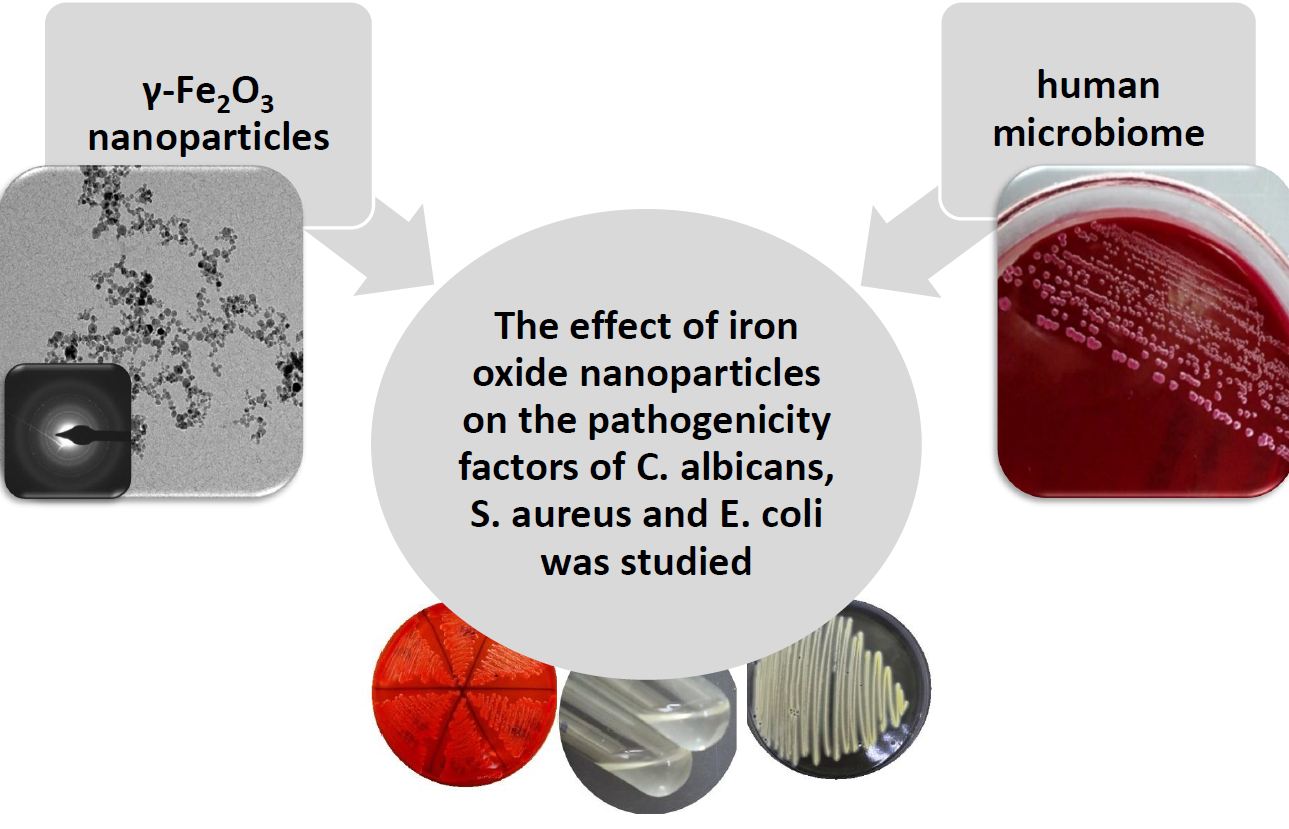
Variability of pathogenicity factors representative of the human microbiome under the influence of γ-Fe2O3 nanoparticles
Abstract
Keywords
Full Text:
PDFReferences
Kurlyandskaya GV, Blyakhman FA, Makarova EB, Buznikov NA, Safronov AP, Fadeyev FA, Shcherbinin SV, Chlenova AA. Functional magnetic ferrogels: from biosensors to regenerative medicine. AIP Adv. 2020;10:12512. doi:10.1063/9.0000021
Zamani Kouhpanji MR, Stadler BJH. A guideline for effectively synthesizing and characterizing magnetic nanoparticles for advancing nanobiotechnology: a review. Sens. 2020;20(9):2554. doi:10.3390/s20092554
Zhigachev AO, Golovin YuI, Klyachko NL. A new physical method of localization of nanomechanical action of magnetic nanoparticles controlled by low-frequency magnetic field on mechanically sensitive biochemical systems. Adv Mater Technol. 2018;3:63–69. doi:10.17277/AMT.2018.03.PP.063-069
Sokolov IL. In vitro and in vivo study of the behavior of hybrid nanostructures with positive magnetic susceptibility for biomaging and targeted drug delivery [dissertation]. Moscow, Russia: Moscow Institute of Physics and Technology (National Research University); 2019. 134 р.
Alonso J, Khurshid H, Devkota J, Nemati Z, Khadka NK, Srikanth H, Pan J, Phan M-H. Superparamagnetic nanoparticles encapsulated in lipid vesicles for advanced magnetic hyperthermia and biodetection. J Appl Phys. 2016;119:083904. doi:10.1063/1.4942618
Khawja Ansari SAM, Ficiara E, Ruffinatti FA, Stura I, Argenziano M, Abollino O, Cavalli R, Guiot C, D’Agata F. Magnetic iron oxide nanoparticles: synthesis, characterization and functionalization for biomedical applications in the central nervous system. Mater. 2019;12:465. doi:10.3390/ma12030465
Aphesteguy JC, Jacobo SE, Schegoleva NN, Kurlyandskaya GV. Characterization of nanosized spinel ferrite powders synthesized by coprecipitation and autocombustion method. J Alloy Compd. 2010;495:509–512. doi:10.1016/j.jallcom.2009.10.037
Goiriena-Goikoetxea M, García-Arribas A, Rouco M, Svalov AV, Barandiaran JM. High-yield fabrication of 60 nm Perm-alloy nanodiscs in well-defined magnetic vortex state for biomedical applications. Nanotechnol. 2016;27:175302. doi:10.1088/0957-4484/27/17/175302
Kurlyandskaya GV, Safronov AP, Shcherbinin SV, Beketov IV, Blyakhman FA, Makarova EB, Korch MA, Svalov AV. Magnetic nanoparticles obtained by electrophysical tech-nique: focus on biomedical applications. Phys Solid State. 2021;63:1447–1461. doi:10.1134/S1063783421090237
Bazylinski DA, Frankel RB. Magnetosome formation in pro-karyotes. Nat Rev Microbiol. 2004;2:217–230. doi:10.1038/nrmicro842
Grossman JH, McNeil SE. Nanotechnology in Cancer Medicine. Phys Today. 2012;65:38. doi:10.1063/PT.3.1678
Denisova TP, Simonova EV, Kokorina LA, Maximova EN, Samatov OV. Heterogeneity of population of microorganisms grown in presence of iron oxide maghemite nanoparticles. EPJ Web Conf. 2018;185:10002. doi:10.1051/epjconf/201818510002
Babushkina IV, Korshunov GV, Puchinyan DM, Vlasova SP, Fedorova AV, Goroshinskay IA, et al. Antibacterial effect of iron and copper nanoparticles on Pseudomonas aeruginosa. Izvestiya vuzov. The North Caucasus Reg. Nat Sci. 2010;2:82–84. Available from: https://cyberleninka.ru/article/n/antibakterialnoe-deystvie-nanochastits-zheleza-i-medi-na-klinicheskie-shtammy-rseudomonas-aeruginosa, Accessed on 10 May 2022.
Durnev AD. Assessment of the genotoxicity of nanoparticles when used in medicine. Hygiene Sanit. 2014;93(2):76–83. Available from: https://cyberleninka.ru/article/n/otsenka-genotoksichnosti-nanochastits-pri-ispolzovanii-v-meditsine, Accessed on 7 May 2022.
Mikhailova EA, Mironov AYu, Fomina MV, Kirgizova SB, Aznabayeva LM, Zherebyatyeva OO. The ability of Escherichia coli to form biofilms in the presence of aluminum oxide nanoparticles. Clin Lab diagn. 2017;6:381–384. Available from: https://cyberleninka.ru/article/n/sposobnost-escherichia-coli-formirovat-bioplenki-v-prisutstvii-nanochastits-oksida-alyuminiya, Accessed on 7 May 2022.
Kosyan DB, Makaeva AM, Rusakova EA. Biological effects of silicon dioxide nanoparticles. Mod Probl Sci Educ. 2018;6. Available from: https://science-education.ru/ru/article/view?id=28276, Accessed on 7 May 2022.
Castro-Gamboa S, Garcia-Garcia MR, Piñon Zarate G, Rojas-Lemus M, Jarquin-Yañez K, Angel Herrera-Enriquez M, et al. Toxicity of silver nanoparticles in mouse bone marrow-derived dendritic cells: Implications for phenotype. J Immunotoxicol. 2019;16(1):54–62. doi:10.1080/1547691X.2019.1584652
Abramenko NB. Investigation and modeling of the toxic effect of silver nanoparticles on hydrobionts [dissertation]. Moscow, Russia: State University named after M.V. Lomonosov; 2017. 122 p.
Zaitseva NV, Zemlyanova MA, Stepankov MS, Ignatova AM. Assessment of toxicity and potential danger of aluminum oxide nanoparticles for human health. Human Ecol. 2018;5:9–15. Available from: https://cyberleninka.ru/article/n/otsenka-toksichnosti-i-potentsialnoy-opasnosti-nanochastits-oksida-alyuminiya-dlya-zdorovya-cheloveka, Accessed on 7 May 2022.
Candida albicans (Robin) Berkhout. Available from: https://www.atcc.org/products/10231-mini-pack, Accessed on 10 May 2022.
Staphylococcus aureus subsp. aureus Rosenbach. Available from: https://www.atcc.org/products/25923, Accessed on 10 May 2022.
Escherichia coli (Migula) Castellani and Chalmers. https://www.atcc.org/products/25922, Accessed on 10 May 2022.
Gruber IM, Egorova NB, Astashkina EA. Pathogenicity fac-tors of Staphylococcus aureus their role in the infectious process and in the formation of post-vaccination immunity. Epidemiology and vaccination prevention. 2016;15(3):72–82. doi:10.31631/2073-3046-2016-15-3-72-82
Ivanova EI, Popkova SM, Dzhioev YP, Dolgikh VV, Rakova EB, Bukharova EV. Detection of some genes encoding pathogenicity factors in typical isolates of Escherichia coli. Acta Biomed Sci. 2014;5(99):89–94. Available from: https://cyberleninka.ru/article/n/detektsiya-nekotoryh-genov-kodiruyuschih-faktory-patogennosti-u-tipichnyh-izolyatov-escherichia-coli, Accessed on 10 May 2022.
Haitovich AB, Gafarova AS. Pathogenicity factors of Candida albicans and determination of their gene determinants. TMBV. 2016;3:121–126. Available from: https://cyberleninka.ru/article/n/faktory-patogennosti-candida-albicans-i-opredelenie-ih-gennyh-determinant, Accessed on 10 May 2022.
DOI: https://doi.org/10.15826/chimtech.2022.9.4.01
Copyright (c) 2022 Lyubov A. Kokorina, Yana V. Chernyavskaya, Tatiana P. Denisova, Elena V. Simonova, Alexander P. Safronov, Galina V. Kurlyandskaya

This work is licensed under a Creative Commons Attribution 4.0 International License.
Chimica Techno Acta, 2014–2025
eISSN 2411-1414
Copyright Notice







